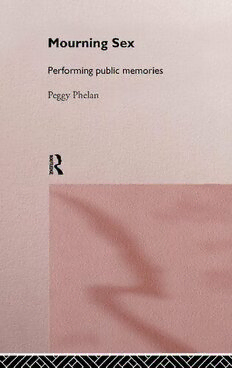Table Of ContentMourning Sex
This is a book about the exhilaration and the catastrophe of embodi
ment. Analyzing different instances of injured bodies, Phelan considers
what sustained attention to the affective force of trauma might yield for
critical theory. Advocating what she calls "performative writing", Phelan
creates an extraordinary fusion of critical and creative thinking which
erodes the distinction between art and theory, fact and fiction.
The bodies she examines here include Christ's, as represented in
Caravaggio's painting The Incredulity of St Thomas; Anita Hill's and
Clarence Thomas's bodies as they were performed during the senate
hearings; the disinterred body of the Rose Theatre; exemplary bodies
reconstructed through psychoanalytic talking cures; and the filmic
bodies created by Tom Joslin, Mark Massi, and Peter Friedman in
Silverlake Life: The View From Here.
This new work by the highly acclaimed author of Unmarked makes a
stunning advance in performance theory in dialogue with psycho
analysis, queer theory, and cultural studies.
Peggy Phelan is Chair of the Department of Performance Studies, Tisch
School of the Arts, New York University.
This page intentionally left blank
Mourning Sex
Performing Public Memories
Peggy Phelan
~l Routledge
~ ~ Taylor & Francis Group
LONDON AND NEW YORK
First published 1997
by Routledge
Published 2013 by Routledge
2 Park Square, Milton Park, Abingdon, Oxon OX14 4RN
Simultaneously published in the USA and Canada
by Routledge
711 Third Avenue, New York, NY, 10017, USA
Routledge is an imprint of the Taylor & Francis Group, an informa business
© 1997 Peggy Phelan
All rights reserved. No part of this book may be reprinted or
reproduced or utilized in any form or by any electronic,
mechanical, or other means, now known or hereafter
invented, including photocopying and recording, or in any
information storage or retrieval system, without permission in
writing from the publishers.
British Library Cataloguing in Publication Data
A catalogue record for this book is available from the British Library
Library of Congress Cataloguing in Pllblication Dlltll
Phelan, Peggy.
Mourning sex: performing public memories / Peggy Phelan.
p. cm.
Includes bibliographical references and index.
1. Psychic trauma. 2. Loss (Psychology). 3. Grief.
4. Psychoanalysis and culture. 5. Bereavement - Psychological
aspects - Cross cultural studies. I. Title.
BF175.5.P75P48 1997
155.9'37 - dc20 96-9345
CIP
ISBN 13: 978-0-415-14758-3 (hbk)
ISBN 13: 978-0-415-14759-0 (pbk)
For the Cure
by Love
This page intentionally left blank
Contents
List of figures viii
Acknowledgments ix
1 Introduction: this book's body 1
2 Whole wounds: bodies at the vanishing point 23
3 Immobile legs, stalled words: psychoanalysis and
moving deaths 44
4 Uncovered rectums: disinterring the Rose Theatre 73
5 Bloody nose, loose noose: hearing Anita Hill and
Clarence Thomas 95
6 Shattered skulls: Rodney King and Holbein's
The Ambassadors 119
7 Failed live(r)s: whatever happened to her public grief?
In memory of Rena Grant (1959-1992) 129
8 Infected eyes: Dying Man With A Movie Camera,
Silverlake Life: The View From Here 153
Bibliography 174
Index 181
Figures
1 Velasquez, Las Meninas (1646). Copyright The Prado Gallery.
Reproduced with permission. 26
2 Caravaggio, The Incredulity of St Thomas. Copyright the
Superintendency for Artistic and Cultural Heritage of
Florence, Pistoia and Prato. Reproduced with permission. 29
3 Robert Mapplethorpe, Lou, N.Y.c., 1978. Copyright 1978
The estate of Robert Mapplethorpe. Reproduced with
permission. 38
4 Rose Theatre, aerial view. Copyright Andrew Fulgoni
Photography. Reproduced with permission. 86
5 Anatomical drawing of the male rectum. From Frank Netter's
Atlas of Human Anatomy, 1989, Ciba-Geigy Corporation:
Schmit, NJ. Reproduced with permission. 87
6 De Formatu Foetu, Adrian Spigelius, 1626. Copyright
The British Library. Reproduced with permission. 90
7 Longitudinal section of the Burrell Foley design viewed from
Rose Alley. Reproduced with permission of John Burrell. 91
8 Holbein, The Ambassadors. Copyright The National Gallery.
Reproduced with permission. 120
9 Film still from Joslin's Silverlake Life, taken by Carolyn Shapiro. 168
Acknowledgments
I was fortunate to be a Fellow at the University of California-Irvine,
Humanities Research Institute, under the direction of Mark Rose, in
the spring of 1993. As a participant in the "Choreographing History"
seminar, convened by Susan Foster, I have benefitted from conversa
tions with other colleagues in residence, especially Randy Martin, Mark
Franko, Sally Ness, Marta Saviligiano, Heidi Gilpin, Linda Tomko, and
Lena Hamergren. Debby Massey made my life and times in Irvine infi
nitely more pleasant and I remain grateful to Chris Aschan, Sauni Hayes,
and all the staff for their efficiency, good will, and most especially, for
the gift of the garlic press.
The Australian National University of Canberra, Australia, hosted me
for several months in 1995 under the auspices of their Humanities
Research Centre. I am grateful to Graeme Clarke, lain McCalman, and
their staff for providing me with space, a computer, and a tranquil envi
ronment in which to write.
My colleagues at the Tisch School of the Arts, New York University,
continue to provoke and stimulate my thinking. As department chair I
have had the sobering experience of appreciating retrospectively what
it actually takes to make it possible for faculty members to write. The
people who have made it possible for me to write this include: Joe
Simmons, Todd Rinehart, Jackie Allen, Assistant Dean Peggy Wreen,
Dean Mary Schmidt Campbell, my students, and my faculty colleagues
in Performance Studies.
I am grateful to Christina Duffy, Carolyn Shapiro, Branislav
Jakovljevic, and Kirsten Stammer Fury for their many hours of research
assistance, correspondence, and interest. Kirsten has been especially
helpful to me in preparing the bibliography, acquiring permissions,
and attempting to keep me more or less sane in the final months of
this project. Branislav helped me with the copy editing and indexed the
book. Their collective intelligence and good grace gives me great confi
dence in the future of progressive critical thought.

